Back to the Main Page
Astronomical Resources
Optical Configurations
My TeleKit
Credits, Disclaimers & Accolades
The Obligatory Links Collection
About Me
Email me

|
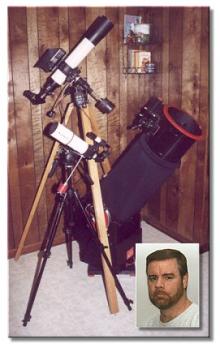
|
|
Then again, all in all ATMs (Amateur Telescope Makers, of which group I could barely be called a member) aren't that much diffferent from any other group of hobby enthusiasts. It's for these folks that I've put together this display of my modest telescopes. |
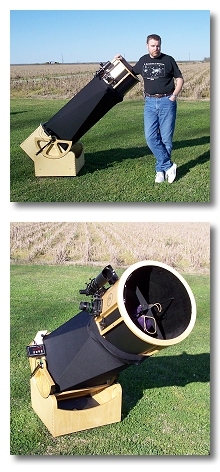
|
14.5 inch AstroSystems TeleKit I inherited a 14.5" Sky Designs Dobsonian from my dear friend Kathey Nix, and purchased the TeleKit to re-house the optics. I'll have more photos here when I get time, but what you see right now is a last minute update prior to me leaving for the 2004 Texas Star Party... more to come. |
|||||||||||||||
|
After seeing a number of TeleKits, both at the Texas Star Party, the Deep South Regional Star Gaze and elsewhere, I was thoroughly impressed. Aside from the obvious beauty of the kit, something that struck me was how consistently good they looked from kit to kit. Given the inherent variances in skill from builder to builder, for them to look that consistently good, the kits themselves must be good. In May of 2003, I called Randy Cunningham and ordered the kit, along with a Dew Guard secondary heater, Rigel QuikFinder and a couple of other later additions. Although initially promised in three months, actual delivery of the kit took about nine months (for the final items to arrive). However, I still had plenty of time to get it ready for both the Mid South Star Gaze in French Camp, MS in April of 2004, as well as the Texas Star Party a month later. The kit itself is extremely high quality Baltic Birch plywood, from Russia (with love?). Typically, it has 13 to 15 plies in a 3/4" thick piece, all hardwood, and virtually no voids at all. The wood is extremely dense - In fact, as a test of humidity and moisture resistance, I took one of the scrap pieces Randy provided and left it, unfinished, in my storage building for a couple of months. During that time, I also put a piece of 3/4" B/C plywood in the shed. Over the course of a weekend, the B/C plywood warped considerably (as expected). Over several months, the Baltic Birch sample never bent in the slightest... as Randy said, it's vitually impervious to moisture, even raw. AstroSystems cuts the kit pieces using a CNC (computer numerically controlled) router, and the end result is impressively precise. There were only a very few situations where I found myself having to "intentionally" add precision - In all other instances, the kit took care of itself, if that makes sense. Once epoxied, routed, sanded and finished, the kit came to life. The change in appearance between the raw wood and varished surfaces was astounding. Even several weeks after the varnish cured, the kit continued to slowly and slightly darken to a rich deep honey color. Despite my best efforts, a bit of skew crept into the rocker box, apparently between the time I last checked it (while it was clamped) and when the epoxy finally cured. The rocker box turned out to be not-quite square, but not off enough to be a problem. Although the scope would have worked just fine as-is, after adding one small (1/2" square) additional Teflon pad to the side of the mirror box there's no way to even tell it's "off" at all. The motions are smooth, it's beautiful in appearance and built like a tank - All in all, I'm delighted with the results. I'll try to put together a separate page covering the assembly of the kit (with more, larger photos) as soon as I can find time... For a more detailed telling of the assembly of the TeleKit, here's a story I sent to Rod Mollise which appeared in the Summer 2004 issue of his excellent SkyWatch newsletter. |
||||||||||||||||
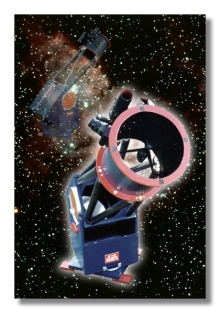
|
10 inch Dobsonian, homebuilt (with liberal usage of commercial components)
This scope was sold in the summer of 2003. |
|||||||||||||||
|
This scope was constructed during the fall and winter of 1991, while waiting on the arrival of the optics. It has a 10 inch f5.51 Coulter Optics primary, with a 1.83” Telescopics secondary mirror. After receiving an f4.5 mirror that was mistakenly thought to be f5.6 (with a correspondlingly extreme comparator index), I got this mirror. It seems to be good, although I've never had it tested (one of these Other hardware includes Novak heavy-duty mounts and trunnion rings, an excellent JMI NGF-3 focuser (which replaced the helical Telescopics focuser I originally had on the scope), Telrad®, Parks 8x50 finder and some rings I got from Rex Allen (Rex's Astro Stuff - 501.331.3773). I was very pleased to have achieved smooth motions in both axes, due no doubt to chance more than any skill on my part. Although not exactly "hardware" ("software", maybe?), I also have a black Lycra/Spandex light skirt (shroud). The first one I made was just about right, only a little too small... So, I made another one and it fits great. It has that nice "drum tight" appearance when it's in place. The best part was the look I got from the lady at the fabric store: When I asked for some black Spandex, she asked what I was making. I replied, "A skirt". She kinda backed up and just pointed across the store, "It's over there..."! For those of you interested in such things, here are the approximate weights of the components :
This photo is about 6 years old, so you don't see the Lumicon NGC Sky Vector I've installed. Also, it's been repainted, changing all the blue parts to black. Although the scope won ”Best Telescope and Mount” at the 1992 Deep South Regional Stargaze, I suspect this was strongly due to a lack of competition from more skilled builders... For a later photo, look at the top of this page. |
||||||||||||||||

|
4 inch Tele Vue
Genesis (commercial) |
|||||||||||||||
|
I had long heard of the Genesis' reputation for excellence. So, when I came across
an offer to sell a used one for less than a thousand dollars, I couldn't resist. This
one is an early model with a removable dew shield, rather than the style that slides
back onto the optical tube. Optically, it's a 4 inch f5.0 double achromat. I
say ”double achromat”, since although it's apochromatic in performance,
physically there are two achromat elements: one at each end of the tube. It's mounted on an older Celestron (Vixen) standard Polaris equatorial mount, which is more than adequate for visual work with this size scope. I've replaced the usual adjustable tripod legs with 5' solid red oak, non-adjustable legs for more stability. It's driven by a single axis drive with a dual speed controller. Once again, this is fine for visual work and a few simple photos could probably be coaxed from it. However, for real astrophotography, something much more accurate would be needed. The previous owner attached a couple of metal plates to the clamp ring, so I've been able to mount both a 6x30 finder and a Telrad® to these plates, in addition to using them as a mounting point. In comparison to other scopes, I've not really done a serious direct comparison. However, I was unable to tell any great difference between this scope and an Astro- Physics Traveller on the same object at the same time. Any differences I saw were probably ”local” in nature, meaning that they could be attributed to seeing, indiviual differences in these particular scopes or my vision. All in all, it's a great telescope, really nice as a small deep sky instrument. The combination of a Genesis and a 9mm Nagler or 27mm Panoptic is impressive, to say the least. However, as fine as this scope is, I'm starting to question whether to sell it or not. You see, after 15 years in the hobby, I think I'm starting to see the early stages of a mild case of aperture fever... I'd love to replace my 10" with a 15 or 16 inch Dob, however, I'll need to assist financing in some manner, so I may come to the conclusion that I need to unload a scope or two... only time will tell. |
||||||||||||||||
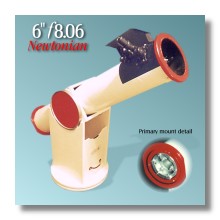
|
6 inch Dobsonian, re-homebuilt
|
|||||||||||||||
|
Although this isn't my scope, I've included it here since I (re)built it for
my wife's uncle. I bought the OTA (optical tube assembly) from Tut Campbell
and built the mount, although I pretty much rebuilt the OTA as well. The full-thickness
f8.06 primary mirror seems to be good, but it's of unknown pedigree since I don't know
who made it. The primary mount appears to be either one of the older Jaegers or
University Optics mounts. The secondary mount and spider were of a type I'd not
encountered before. A Meade focuser and Telrad® finish it off. After waxing the laminate used for the altitude bearing, this mount is probably one of the easiest-moving Dobsonian mounts I've seen. However, that's not too uncommon with small (read: light-weight) Dobsonians. There's one additional part of the telescope that is absent from the photo: a handle on top of the cradle box for carrying the OTA. I must have been inattentive when cutting the background off of the original photo image (shot in my living room), as I also cut off the handle! Apparently, it was one of those late-night photo editing sessions... |
||||||||||||||||

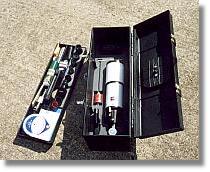
|
3.1 inch Orion Short Tube 80
|
|||||||||||||||
|
Yeah - I have one of these, too! I picked up the OTA used at a star
party and mounted it on a Bogen 3211 tripod with a 3126 fluid head. The
tripod was actually bought with and for the Orion 10x70 Little Giant
binoculars I purchased several years ago. It works with the ST80, but
I eventually made something better (below). My impressions have followed closely those of Ed Ting and others I've read. It's certainly not an Astro-Physics, but neither was the price I paid. For the money, I can't complain at all. Although low power planetary views are OK, don't try to push it. Where this little scope excels is on wide-field deep sky vistas. I could easily stay busy an entire observing session just cruising around the Milky Way looking at clusters. Several reviewers have reported pinched optics on these Chinese-made refractors, but I don't think the objective is pinched in this particular unit. However, there does appear to be a slight bit of diffraction from the fairly large spacer strips between the elements of the achromat. My primary complaint is not optical - It's mechanical. In this unit (at least), there's a considerable amount of drawtube slop when it's extended from the focuser a bit. I've not yet given it a serious look, but I suppose I can do something about it with a reasonable amount of effort. It's possible to minimize it by keeping the drawtube lock screw just slightly less than tight - loose enough to focus, but tight enough to stabilize it. I later purchased a small tripod and EQ mount from Rex's Astro Stuff for astronomical use of the scope. The Bogen tripod, while of excellent quality, is simply just a bit light for astronomical use. However, for terrestrial viewing, it's quite sufficient. Although the EQ-1 mount and tripod are fine, I quickly discovered that I'm too tall (6'2") to easily use it for astronomical observing, particularly at the zenith!. As a result, I finally (almost 2 years later) built a lightweight oak alt-az tripod and mount for the little scope. It works great, although I'll never put anything on this tripod any heavier than the 80. Then again, that was part of the design - Make it sufficient, but not heavier than necessary. It's also tall enough to make observing pleasant instead of gruelling. All in all, it's a great little scope that travels well and observes just as well. I fixed up a 24 inch tough plastic toolbox to make a quick "astronomy-in-a-minute" kit. In the bottom of the box, I've custom-cut foam for the scope, counterweight, LED finder and a pair of 10x25 binoculars. In the tray, I'm able to include oculars, a 90° diagonal, a 45° upright-image prism, extension tube, 6x30 finder, filters, LED flashlight, a couple of tools, a David Chandler mini-planisphere, The Field Guide to the Stars and Planets and Richard Dibon-Smith's The Constellations Pocket Guide, in addition to a small printout of my personal eyepiece spreadsheet and a T-ring / camera adapter tube set! Just grab the box and tripod, and head out! ...(or throw it in the trunk at the very last minute when going on family vacations, for minimal fuss from the wife... "Look, Hon... I didn't know that was in the trunk!" :)
|
||||||||||||||||
